#reptile bed fossil
Explore tagged Tumblr posts
Photo
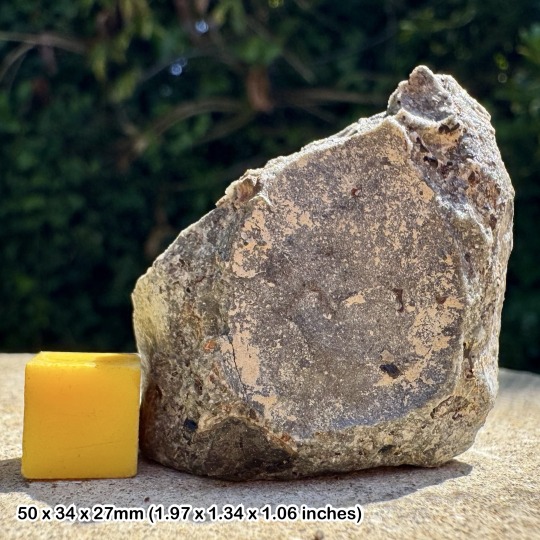
RARE Fossil Fish Tooth – Westbury Formation, Aust Cliff, Bristol – Upper Triassic Coprolite Bed UK
This is a rare and authentic Fossil Fish Tooth preserved in a matrix block from the world-famous fish, reptile and coprolite bed at Aust Cliff, near Bristol, UK. It was discovered by our experienced fossil hunting team, Alister and Alison, on 07 April 2025, and has been expertly cleaned, prepared, and stabilised by Alison.
This fossil originates from the Westbury Formation, part of the Penarth Group, and dates to the Upper Triassic period (~205 million years ago). The Westbury Formation is especially well-known for its rich assemblage of vertebrate remains, including fish, marine reptiles, and the distinctive spiral coprolites (fossilised dung) attributed to large predatory fish like Ceratodus and Agkistracanthus.
Geological Details:
Formation: Westbury Formation
Group: Penarth Group
Age: Upper Triassic (Norian–Rhaetian)
Location: Aust Cliff, Bristol, UK
Depositional Environment: Marine shelf – low-energy anoxic conditions aiding preservation
Fossil Type & Preservation:
Fossil Type: Fish tooth
Condition: Well-preserved in natural matrix, shows diagnostic cuspate form
Associated Matrix: Often includes surrounding coprolite fragments and occasional reptile bone
Notable & Scientific Importance:
The Aust Cliff beds are one of the most studied vertebrate-bearing Triassic localities in Europe.
Fossils from here contribute to our understanding of prehistoric marine ecosystems and extinction/recovery events before the Jurassic.
Why Buy This Fossil?
100% Genuine Specimen – ethically sourced and prepared by UK-based specialists
Comes with a Certificate of Authenticity
You will receive the exact fossil shown in the photos
Ideal for collectors, educators, or anyone with an interest in Earth’s history
Please Note: Scale cube = 1cm. For full sizing and close-up views, please refer to the photograph.
Add this exceptional piece of Triassic history to your fossil collection today!
#Fossil fish tooth#Aust Cliff fossil#Upper Triassic fossil#Penarth Group#Westbury Formation#fish coprolite bed#genuine UK fossil#fossil with certificate#Westbury fish bed#reptile bed fossil#Bristol fossil tooth#fossil collection#Triassic fish fossil#fossil bones UK
0 notes
Text
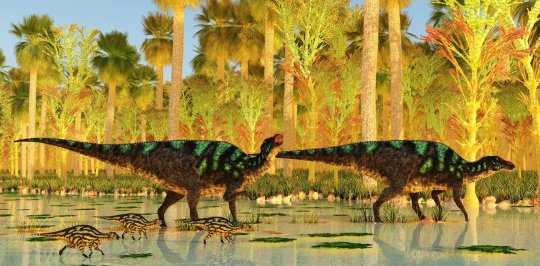
[ Life reconstruction of a small herd of Maiasaura by Shutterstock user Catmando. ]
"Possibly the best growth series of dinosaur bones in the world comes from the fossil beds of the Two Medicine Formation in the U.S. state of Montana. Fossils from this formation have yielded much information about the eggs, hatchlings and early lives of a dinosaur named Maiasaura (meaning "good mother reptile"). This herbivorous hadrosaur apparently tended her eggs and raised her offspring for more than a year after hatching. Young Maiasaura grew astonishingly fast, reaching 200–400 kilograms by their second year, and more than 3,000kg by their teens. In comparison, cold-blooded saltwater crocodiles today weigh only about 6kg at the age of two, and reach adulthood at between 10 and 16 years old, when females weigh about 34kg and males about 115kg. Such high growth rates in Maiasaura involved rapid lengthening and thickening of their long bones, and the process doubtlessly required much oxygen and nutrients from the blood. The shafts of long bones of the leg, such as the femur (thigh bone) and tibia (shin bone), are supplied with blood by the principal nutrient artery, which enters the bone through a hole (called a foramen) that is visible on the surface."
Read more: "Holes in baby dinosaur bones show how football-sized hatchlings grew to 3-ton teens" by Roger S. Seymour.
#palaeoblr#Palaeontology#Paleontology#Maiasaura#Dinosaur#Cretaceous#Mesozoic#Extinct#Prehistoric#Article#Art#Information
253 notes
·
View notes
Text
Fish of the Day
Today's fish of the day is the Freshwater Plesiosaur!
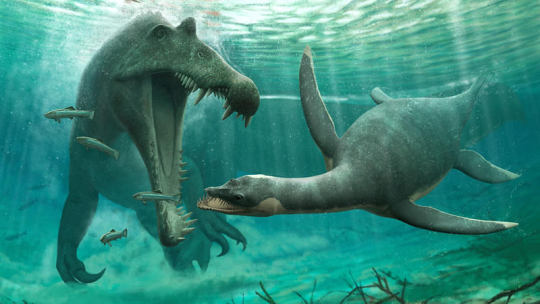
The freshwater plesiosaur was requested by Jasper, thank you Jasper! Plesiosaurus as a marine reptile, well known for their prowess as apex predators, but freshwater plesiosaurs are a relatively new idea. Based on the finding of a couple of fossils in what is now Morocco's Sahra desert river system, specifically an area called the Kem Kem beds. These fossils are scattered, showing us that this is not just the bones of one animal but a group of freshwater plesiosaurs that lived in the area, at least a dozen of them. The finding of many teeth in particular shows that these animals didn't just swim in from the ocean temporarily, but lived in the area long enough to shed teeth. This has led to some theories that the popular cryptid, The Loch Ness Monster, may be a freshwater plesiosaur, although no fossils have been yet found in that area. Although this does not confirm their existence it raises a strong argument for them. However, with limited knowledge about them for the time being, let's go over plesiosaurs in general!
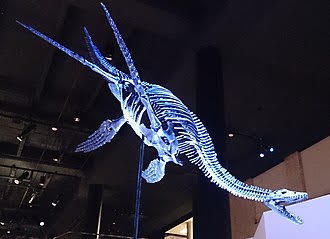
Found and named in the early 1800's the plesiosaur, from order Plesiosauria, is thought to have first appeared in the late Triassic Rhaetian stage, about 203 million years ago. These animals went extinct about 66 million years ago, to the Cretaceous-Paleocene extinction event. How they swam is still up for debate, many favor the theory that they had wide range with each of their fins, and had identical strokes, but other theories are that they may have used only the fore or hind fins for locomotion, or perhaps used them in reciprocal movement. Similar debate exists for how these animal may have dived, although we know they dived for food, as signs of decompression sickness have been found. As apex predators they ate through anything they could get close to, small fish, larger fish, sharks, cetaceans, crustaceans, one another. It is found that although they were certainly near the top of the food chain, some of them were still occasionally prey for large sharks, but mostly they fell to one another, larger plesiosauria hunting smaller. It is thought they evolved to fill the niche left open by the extinction of Ichthyosaurs, which died out in the late Cretaceous, and allowed for diversification to take place in Plesiosauria. Plesiosauria during this era evolved two distinct morphological types: the pliosauromorph build, the Pliosauroidea family, and the plesiosauromorph build, the Plesiosauroidea family.
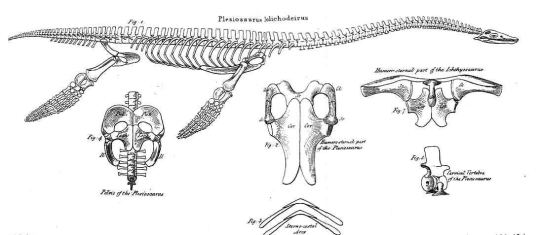
Pliosauroidea is defined by their large heads and short necks, often compared to the build that crocodiles have. They are also known for having larger hind flippers than other plesiosaurs and can be found mostly across South America, and along the equator, although some fossils have been found as far north as Norway. The largest genus found so far, the Liopleurodon, is as large as 6 feet 5 inches, or just a little under 2 meters.

Plesiosauroidea was defined by the long skinny neck, which was used to hunt in small holes, and could move fast to snap up small marine animals nearby them. Although Plesiosauroidae is often depicted as a fast moving predator, it is found that they were likely slow swimmers, pushing their way through the water similar to the swimming methods of turtles, staying close to the surface and using their four limbs for mobility, making it easy to snap at nearby animals. Despite the common displays of them in swan-like positions, with the head raising out of the water, this is unrealistic, as they could not raise their heads up to a degree like that, and the weight of the muscles would prevent them from surfacing. The size difference between differing species was huge, as some could be only as large as 3 meters to 20 meters in length. It is currently thought that the freshwater finds belong to Plesiosauridea.
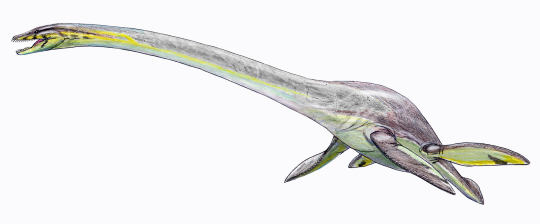
Everyone have a good day!
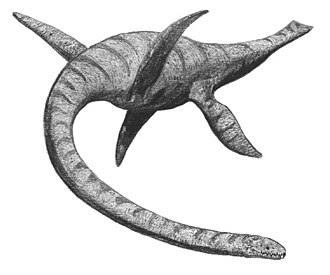
#fish#fishblr#fishes#fishposting#aquatic biology#aquatic#marine biology#ichthyology#marine animals#marine life#freshwater#freshwater fish#animal#animals#animal facts#fish of the day#information#education#nature#river#paleo#paleontology#plesiosaur#plesiosaurus#freshwater plesiosaur#Plesiosauria#Pliosauroidea#Plesiosauroidea
29 notes
·
View notes
Note
(Resending it but fixing up what I FORGOT to type 😭😭😭)
Haii I was wondering if u could make a regressor!Syzoth(reptile) from mortal kombat 1 moodboard? (and maybe some headcanons if your able) please and thank uuuu -🐯
Sure thing! I hope you enjoy! Thank you for the request. :)
💚.。.:*:.。.🐍.。.:*:.。.🧃.。.:*:.。.🕯

Regressor! Syzoth agere moodboard for anon! (*’▽’*)♪

🐍Headcanons🐍
🌿Syzoth will often prefer more chew toys, teethers, and soft toys he can put in his mouth and chew on when in his reptilian form. When in human form he'll wear chewelry.
💚When excited, Syzoth will run around with a toy in his mouth often like an enthusiastic puppy! :3 It helps get some of that energy out.
🧃Ashrah and Baraka would definitely watch over the little one. Syzoth excitedly running up to them with a new game to play.
🌿One of Syzoth's favorite little games to play is "digging for fossils". Whether that be the little kits found in shops or a homemade one that one of his caregivers makes, hiding trinkets in dirt for Syzoth to find.
💚Syzoth also like to play with sand! Making sand castles, hiding/finding shells, it excites him! You can find him playing in a little sand box frequently with small toys scattered in the sand all around him.
🧃It's easy to tucker this little one out. On very low energy days, Syzoth grabs his favorite blanket (the perfect one for warmth), dresses in a large onesie, takes a plush friend and brings it with him to bed, curling up around himself to keep warm. The little guy is out like a light! 💤

Moodboard made with Picsart! ☆
Click moodboard for better quality! <3
Please let me know if there are any typos or mistakes! :)
Requests: CLOSED!
Dividers by: @attxnt



#safe agere#age regression#agere#agere moodboard#agere headcanons#fandom agere#mortal kombat agere#moodboard#headcanons#requests
34 notes
·
View notes
Text
Jurassic Park 3 AU
This is my JP3 AU, I am a novice writer so be kind but constructive criticism is appreciated. <3
Chapter 1: Montana Dig Site
In the foothills of Montana, Dr. Alan Grant hunches over to examine a recently uncovered fossil, the hot midday Montana sun beating down on him. He lightly traces the femur bone of the creature, brushing away the burning sand surrounding the bone, noticing a fracture in it.
“Billy,” Grant said. “ it was injured. It most likely died in a fight with another dinosaur, or it was left by its pack to die because of its wound. A fracture like this would make it unable to walk.”
Billy looked up from his clipboard and bent down to look for himself. Billy Brennen was a young fit man, standing about five and a half feet tall, with short hair. He took the back of his pencil to point out another break in the animal's vertebrae.
“I think it could do less than walk, I don't think it could move.” Billy studied its ribs and noticed tiny marks on the ribs.
“It was alive when the scavengers got to it. But it couldn't move. I've seen these marks on other fossils, but these ones are smaller and more careful, meaning that the scavengers were wary of the situation.”
“And that's why we keep you here Billy,” Alan said with a laugh. He stood up with a grunt, with his age it was deserved, being a nearly 60-year-old man. “Vicious creatures,'' Alan said under his breath.
“Velociraptor?” billy asked
“You can debunk that it was eaten alive but you can't identify the creature with confidence? Kids these days.” Alan chuckled as he spoke. “You will get there one day. But at least you got it right, have confidence Billy." Alan began to walk away, still lecturing Billy about how he is smarter than he thinks. Billy wrote down all of the notes they made on his clipboard. Smiling at the fact that he got it right. He looked up to Alan, like the father that he never had growing up. Billy had graduated top of his class in paleontology from Harvard University. He was a smart man with a child-like love for these creatures, but it's not like everyone in the dig didn't have the same love for them. Billy is simply intrigued by these giant creatures because they were so different from modern animals, yet they weren't, they have so many similarities to modern birds and reptiles. It's amazing how life changes to its surroundings, life is truly one of the most powerful forces, because no matter what, it finds a way to keep living. He bent back down to continue to study the raptor, noting things like size, estimated age, and what fossils are missing from the animal.
Alan walked into his tent, setting down his tools, and brushed the dust off his hands. He sat in his desk chair and studied his fossil records. He looked at the newest discovery, the raptor. He compared it to the ones he encountered so long ago. He knew how dangerous they were, but they are so different from what they would have been in reality, Ingens monsters only looked like dinosaurs, though they were far too reptilian compared to recent discoveries. That is the issue with bringing back and trying to recreate extinct animals we have never seen, we can never truly know everything about them, so we can never truly have them back. “Damnit Hammond” he cursed.
Alan leaned back in his chair and sipped the coffee on his desk. He checked his watch, seven fourteen pm. Alan began to stand up and head to his bed to lie down. Billy abruptly burst through the entrance of the tent, speaking frantically at Grant. Billy made swift gestures with his hands and ran out of the tent. Grant, still confused by what just happened, was only able to make out “we found something amazing” and to follow him. Grant stood with another grunt and began speed walking out of the door. As Grant exited the tent, the cool dusk air hit his face and he walked towards Billy, rushing him into the tent.
Grant stepped into the lab tent, looking around and seeing all the scanners, 3D printers, and other technology.
“Dr. Grant! Look at this!'' Billy exclaimed with excitement. Alan walked towards him, getting closer to the machine Billy was standing at.
“Alan, we discovered something amazing about velociraptors, look at the screen” he studied the monitor, it showed a velociraptor skull and neck bones, adding 3D modeled muscles, then suddenly it stopped to show a highlighted area of the throat, then continuing to finish the tissue and feathers.
“What is it highlighting?” Grant asked.
“It's a syrinx, they could vocalize, Alan”
“Like birds?”
“Maybe better”
“Incredible…”
“This is something that could be in so many species, Raptors, Triceratops, Procompsognathus, maybe even the Tyrannosaurus”
“different species would most likely have different capabilities for producing sounds, meaning the development of communication could be based on intelligence”
“Raptors being incredibly smart would be able to communicate well, while triceratops would essentially be an oversized rhino”
“This is amazing Billy, this information will fund our dig for at least 3 more years.”
Alan patted Billy on the shoulder and smiled. As he walked back to his tent to turn in for the night, Billy took out his phone and dialed a number. After two rings, someone on the other side answered.
“It's me,” Billy said gravely, “I got something I think you are going to like.”
#tumblr fyp#i like dinosaurs#jurassic park#Jurassic AU#my au#dinosaurs#dinosaur au#horror#paleontology#novice writer#writers on tumblr#writing
19 notes
·
View notes
Text
I’m now over halfway done with my series explaining the origins of all non-fish aquatic Pokémon. Today will be covering my first generation of games: gen V. To see previous parts of this series see gen I part 1, gen I part 2, gen II, gen III, and gen IV. To see my previous series where I covered all the fish Pokémon see here. You can find the fish of gen V in that series, I had a surprising amount to say about Basculin. As before, starters and mythicals/legendaries will be in their own series.
I’ll start off by saying that Panpour or Simipour aren’t aquatic. For this series I define “aquatic” as meaning the Pokémon has been depicted as living in water in its Pokedex entries or location in the main series games. Neither are true for the monkeys, they’re forest dwellers that use water in their attacks. The actual first aquatic line in the dex (besides Oshawott) is the Tympole line. This line is based on developing frogs, with Tympole being a tadpole, Palpitoad being a tadpole undergoing metamorphosis into an adult, and Seismitoad being an adult.
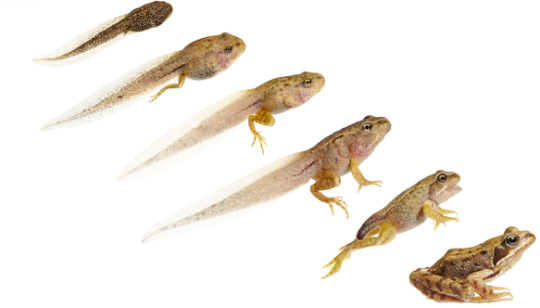
(image: multiple stages of frog development. source)
Frogs are born as fully aquatic larvae that undergo metamorphosis into adults, with the tail being reabsorbed and limbs growing as the body takes its adult shape. Palpitoad is an intermediate stage, still having the tail of a tadpole and having begun to grow hind legs while the forelegs have not yet begun to grow. Seismitoad has lost its juvenile traits and is now an adult toad. Thanks to an interview with Ken Sugimori, we known specifically that Seismitoad is based on the Japanese common toad. The lumps on the line that produce sound and hold poison are based on the lumpy parotoid glands of toads which can release a number of milky secretions collectively called bufotoxins.
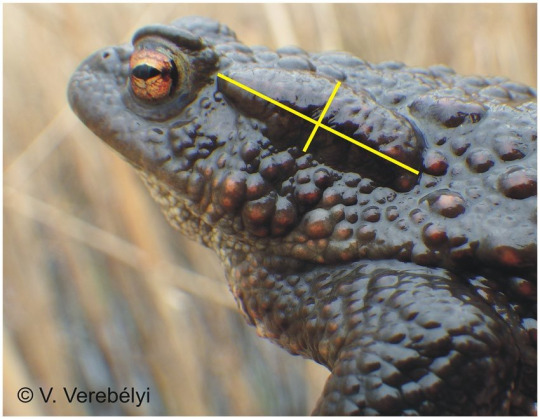
(image: the parotoid gland of a toad highlighted. source)
The lumps on the Tympole line are additionally based on the electrodynamic speaker drivers used in loudspeakers, which convert electrical signals to sound waves by means of vibration. There are always two lumps on the head in this line, possibly a reference to the tympanum, the ear-like organ just behind a frog’s eye that transmits sound to the inner ear.
The Tirtouga line is probably the least interesting of the fossil lines. I think the fossils should look distinct from modern pokemon species but Tirtouga and Carracosta could be modern sea turtles and noting would have to change about their design. Anyway, this line is based on extinct sea turtles, fossils of which can be found at least as far back as the cretaceous period and a proto-sea turtle may have been found that’s 220 million years old. There are a lot of unanswered questions about the evolution of sea turtles. It appears that turtles have evolved to be aquatic multiple independent times and it’s not clear which lineage is the ancestor of modern sea turtles. There have also been several examples of non-turtle reptiles evolving a sea-turtle like body plan. Tirtouga and Carracosta are based on Archelon iscyros, the largest turtle ever discovered, with the largest specimen measuring 4.6 m (15 ft) from head to tail.
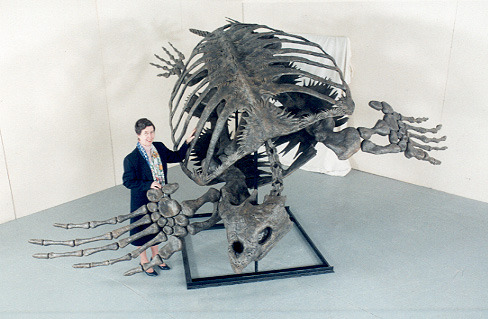
(image: fossil reconstruction of an Archelon with a human for scale)
Ducklett and Swanna are based on the story of the ugly duckling. As such, Ducklett is based on both a duckling and a cygnet (juvenile swan) and is nothing special to look at. It looks a lot more like duckling than a swan to me.
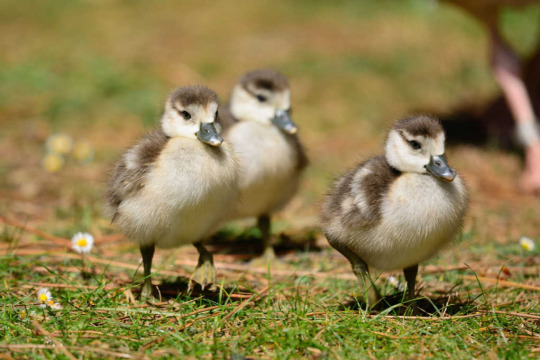
(image: wild ducklings)

(image: a cygnet)
The Pokedex says that Ducklett’s favorite food is peat moss. I tried to look up if ducks can eat peat moss but all I could find were people discussing using it as bedding for pet ducks. Ducks are omnivores and aquatic algae is an important part of their diet. The fluffy feathers in Ducklett’s bottom looks like a swim ring and is based on a duck mid-molt. Swanna is based on the mute swan, which has been introduced to North America (where Unova is) which is home to the largest populations outside of the species’ native range.
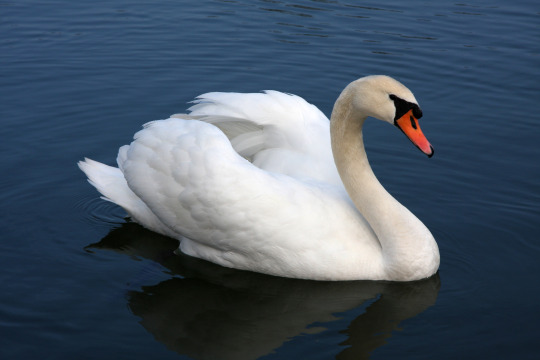
(image: a mute swan)
Swans and ducks are closely related so a duck turning into a swan is not nearly as bizarre as a clam turning into eels (still not over that). Swanna’s plumage makes it look like a ballet outfit and they dance at dusk, a reference to the ballet Swan Lake. The Pokedex mentions that Swanna has powerful wings, which is true to real life as swan wing muscles are strong enough to break human bones.
We finish this entry off with the surprisingly disturbing Frillish line. These regal jellyfish have some very unsettling behavior including sinking ships to feed on the crew and building lards of sunken ships. Also, female Jellicent’s design is extremely creepy to me. It legit gives me uncanny valley vibes. I think it’s the lips, take those away and I wouldn’t get so uncomfortable looking at it. Anyway, they’re jellyfish. Based on their size, hadopelagic habitat, and wide, fabric-like tentacles, they are likely based on Stygiomedusa gigantea, a gigantic (up to 10 meters long with a 1 meter diameter bell) deep sea jellyfish with very distinctive tentacles.
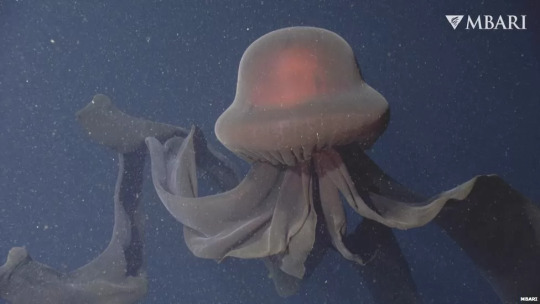
(image a giant phantom jellyfish, one of only a few ever filmed)
Its dark red coloration is similar to the female Frillish line’s pink. They are also inspired by two yokai: the nurarihyon and kurage no hinotama. The former is depicted as either a monstrous jellyfish that looks like a human head or a jellyfish-like slimy old man in regal clothing. The latter is a type of will-o-wisp that looks like a glowing jellyfish and appears over the sea to lead sailors astray. The line also looks like princes and princesses or kings and queens, combining the regal attire of the nurarihyon with Victorian-era fashion. Their behavior of attacking ships and feeding on sailors draws from various sea monster legends from around the world.
That ends gen V. Tune in next time for gen VI as we enter the finishing stretch for this series.
#pokemon#pokemon biology#pokemon lore#marine biology#aquatic biology#animal facts#zoolo#biology#tympole#palpitoad#seismitoad#tirtouga#carracosta#ducklett#swanna#frillish#jellicent#toad#sea turtle#archelon#ducklings#swan#jellyfish
13 notes
·
View notes
Text
Life in the Middle Triassic
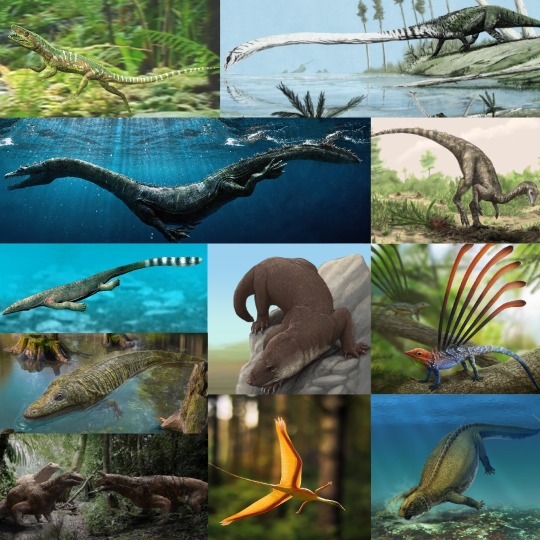
(first row: Euparkeria, Tanystropheus; second row: Nothosaurus, Nyasasaurus; third row: Thalattosaurus (top), Mastodonsaurus (bottom), Cynognathus, Longisquama; fourth row: Shringasaurus, Sharovipteryx, Placodus)
Art by:
Tanystropheus, Nyasasaurus - Mark Witton
Thalattosaurus - Nobu Tamura
Nothosaurus - Johnson Mortimer
Mastodonsaurus - Vladislav Egorov
Sharovipteryx, Longisquama - Julio Lacerda
Shringasaurus - Ntvtiko
Cynognathus - Gabriel Ugueto
Euparkeria - Taenadoman
Placodus - Sergey Krasovsky
The Triassic is a fantastic time if you’re interested in weird creatures and it’s a shame that it often gets overlooked in favor of the more dinosaur-rich Jurassic and Cretaceous. The main reason for the abundance of Triassic weirdos is that the time period was bookended on both sides by mass extinctions: The end Permian mass extinction had just left the planet empty, with lots of opportunities for evolution to go crazy as the the few survivors refilled niches. At the end of the Triassic however (Spoiler alert), another mass extinction wiped out most of the newly established forms, which is why they look so foreign and strange to us - bizarre anomalies that only existed for a brief period of time and didn‘t leave any successors to help us understand them better.
One of those weirdos is leg-winged Sharovipteryx. Because yes, while every other vertebrate on the planet decided that arms are pretty good for flying, Sharovipteryx wanted to not be like other girls and used its legs instead. While it wasn‘t capable of powered flight (only birds, bats and pterosaurs ever accomplished that), it was probably a decent glider (Dyke, 2006).
From the same fossil beds as Sharovipteryx comes another unusual critter: Longisquama. At first glance it might look like your typical little lizard - if it wasn‘t for its back being covered with those long …scales? Feathers? Maybe just plant leaves that somehow fossilzed next to the animal? We really are not sure what exactly is going on with the back of this little guy. Although it seems like the most recent idea is, that those appendages are not feathers in the sense that birds have them, but that both feathers and Longisquama‘s structures might be homologous, meaning that they come from the same origin (Buchwitz, 2012). As for what were they doing with the structures? Probably sexual display, which is the paleontology version of saying “we‘re not sure, but unless you‘ve got a better idea, we‘re sticking with this one“.
(Oh, and btw both Longisquama and Sharovipteryx are prime topics for David Peters, self-proclaimed paleontologist that apparently loves to spread misinformation and seems to have beef with the entire paleo-community - so be cautious when you see something written by him. Man, I really don‘t wanna be involved with paleo drama. I wasn‘t even aware there was paleo drama)
The placement of both Sharovipteryx as well as Longuisquama on the family tree is pretty uncertain, but most likely they fall somewhere around the base of the Archosaur lineage, a group that you will hear a lot about in the future, as it includes the flying pterosaurs, everything related to crocodiles, and of course the dinosaurs. The earliest of those you might see around this time in the form of medium-sized average-looking bipeds like Nyasasaurus.
Also settled around the base of the archosaur line is long necked Tanystropheus (although some of its fossils were believed to be flying pterosaurs for a long time because its neck vertebrae were mistaken for wing finger bones). With a length of around 5 m it was pretty big for the time. It most likely lived a semi-aquatic lifestyle, staying on the shores while it used it oversized neck to catch fish from the water.
During the Triassic we see quite a few reptile groups going for more aquatic lifestyle. While some, like the Thalattosaurs were relatively short-lived, others dominated for most of the age of reptiles. One of the most prominent groups are the Sauropterygia. The name (which translates to “lizard flippers“) might not sound too familiar, but this is the group that will later contain the Loch-Ness-monster looking plesiosaurs and their shorter-necked cousins, the pliosaurs. In the early days of this group the animals weren‘t quite as well adapted for the waters yet, but you can already see were the journey is going. Nothosaurus for examples, lived probably similar to seals, while Placodus was more terrestrial and only spent time in the water to forage for food.
Most of this was all very reptile-focused. That is because by now the synapsids, those early cousins of our own lineage, that roamed the world as giant beasts during the permian, had lost their positions at the top of the food chain. For the most part, they were now constrained to small burrows and dark nights, to the shadows of much larger creatures. Their story does of course not end here, but for the next 170 million years our planet truely was a planet of reptiles.
3 notes
·
View notes
Text
Massacre in Dinosaur Valley (1985)

There’s one genre of horror that feels particularly daunting to explore: the “cannibal horror” genre. Its best-known entry, 1980's Cannibal Holocaust is notorious for its real-life footage of animal killings and anyone whose interest is peaked hearing this probably needs psychological help. Then there’s the inherent racism of these stories: the plots almost always concern a group of urban people who encounter savage aboriginals that want nothing more than to butcher, cook and then eat white meat. You're curious why the genre was so prolific but you don’t want to be offended so you pick the most ridiculous-sounding entry of them all: Massacre in Dinosaur Valley. The idea is that when your hapless explorers are getting torn apart by prehistoric reptiles, it will be easy to forget about what’s socially acceptable and just laugh between the “yuck!” scenes.
Deep in the Amazon jungle live the reclusive Aquera Indians: a tribe of cannibals who have little contact with the outside world. Their territory contains the “Dinosaur Valley”, a bone-bed rich with fossils and hidden dangers. Palaeontologist Kevin Hall (Michael Spokiw), Professor Pedro Ibañez (Leonidas Bayer), his daughter Eva (Suzanne Carvalho), fashion models Belinda (Susan Hahn) and Monica (Maria Reis), Vietnam vet John Heinz (Milton Morris) and his wife Betty (Marta Anderson) are flying over the off-limits area when their plane suddenly crashes. The survivors must find a way back to civilization before they become victims of the jungle surrounding them.
Originally shot in Italian, then dubbed in English, no one - on camera or otherwise - gives a good performance. That only matters so much because you’re not here for high art. What you’re here for is the sleaze. You want nudity? Massacre in Dinosaur Valley has it in droves. We get to see the supermodels changing, Eva showering, a gratuitous sex scene that comes out of nowhere, a sadistic lesbian that can’t wait to tear Belinda’s top off and when the ladies get captured by the Aquera Indians (that’s what the movie calls them so I will too), the cannibals promptly rip off their clothes and give them new outfits that barely cover anything. The objective was to find as many ways to show the actresses barring it all - logic or tact be damned. When Eva is shown in the nude (there’s quite a bit of full-frontal nudity), she’s showering with the doors to the bathroom and hotel room wide open so anyone can walk in. When Kevin wanders inside looking for her father, he gets a nice view. He gives her a towel, but she only realizes a stranger provided the helping hand after about 30 seconds. My question is… who did she THINK was helping her dry off? Her father? Gross.
Speaking of gross, how’s the gore? Disappointing, unfortunately. With a title like Massacre in Dinosaur Valley, you expect to see the idiots who stumble into that green inferno getting dismembered, decapitated, flayed alive and otherwise brutalized before getting eaten - either by dinosaurs or racist caricatures. Someone does get eaten but it’s nothing spectacular and isn’t treated as such either, which is a letdown. By my count, there are two massacres in this movie. Too bad it’s not the people you expect that get reduced to deli meat. Most of our ill-fated adventurers bite the dust because of non-cannibal dangers, which you might not think is a big deal. It’s not called Massacre in Cannibal Valley, am I right? Just wait.
The film could essentially be split into three parts, only one of which has anything to do with that titular valley. Part one is a story filled with quicksand, flesh-eating jungle beasts and other clichés. Part two concerns the cannibals. Part three, the white slavers! Between these three hurried plots, fans of bad movies will have some laughs. There’s plenty of questionable behavior spread throughout, the gratuitous nudity is so outlandish it’s hard not to crack a smile, the body count is so extreme it's hilarious, there are plenty of ideas introduced and then dropped and at points, it’s hard to tell if the movie is implying certain things or if the filmmaking and continuity are just THAT BAD. A lot of stuff just happens because writer/director Michele Massimo Tarantini wanted it to happen. Logic had nothing to do with it.
Massacre in Dinosaur Valley is better shot than you'd think, the plot moves along quickly enough to prevent you from getting bored and it manages to be so incompetent you skip the phase where you’d be offended and go directly to rolling your eyes while chuckling at the pathetic attempts at storytelling. All this SHOULD make for a decent “so bad it’s good” cannibal film… if it weren’t for one glaring flaw. There are no dinosaurs in this movie. None! What a ripoff! (November 5, 2021)

#Massacre in dinosaur valley#movies#films#movie reviews#film reviews#Michele Massimo Tanrantini#Michael Sopkiw#Suzane Carvalho#Milton Rodriguez#Marta Anderson#Joffre Soares#1985 movies#1985 films
2 notes
·
View notes
Text

In which century was the fossil hunter Mary Anning born?
Born at the very end of the 18th century, Mary Anning (1799-1847) was a remarkable woman who made significant contributions to the field of paleontology. Anning's interest in fossils began at a young age. Growing up in the English coastal town of Lyme Regis known for its rich fossil beds, she spent countless hours exploring the cliffs and beaches, searching for ancient treasures. Her discoveries were not only impressive but also groundbreaking. At the tender age of 12, she unearthed the first complete ichthyosaur skeleton, a prehistoric marine reptile that lived millions of years ago. This remarkable find caught the attention of scientists and collectors alike, establishing Anning as a prodigious talent in the field.
One of Anning's most significant discoveries was the first complete plesiosaur skeleton, another marine reptile from the age of dinosaurs. This find caused a sensation in the scientific community and further solidified her reputation as a leading paleontologist. Anning's discoveries also included numerous other fossils, such as ammonites, belemnites, and fossilized fish, which she sold to collectors to support herself and her family.
However, Anning's journey was not without its challenges. As a woman in the early 19th century, she faced significant gender and class discrimination. Despite her expertise and numerous discoveries, Anning was often excluded from scientific societies and denied access to formal education.
4 notes
·
View notes
Text
A Look at AI Applications in Paleontology

Paleontology involves hands-on fieldwork, which forms the foundation of discovery. However, modern paleontology has started using cutting-edge technology, such as CT scanners, artificial intelligence, and 3D printing, to unlock prehistoric secrets.
In the past, the only way to study the interior of a fossil was to carefully cut it open—a destructive and irreversible process. Computational tomography (CT) scanning allows paleontologists to create detailed, three-dimensional images of a fossil’s internal structure without damaging it. This technology, borrowed from medical imaging, allows researchers to examine everything from the growth rings inside a dinosaur bone to ancient reptiles' delicate inner ear canals. These internal clues can reveal an animal’s age, growth rate, and even behavior, offering glimpses into prehistoric lives that skeletons alone can’t fully explain.
CT scanning has even enabled the study of fossils still encased in rock. By adjusting the scanner’s settings, scientists can digitally "remove" the stone and isolate the fossil, allowing them to visualize and study it before fully excavating it. This non-invasive method protects fragile specimens and often reveals previously hidden features that add new chapters to the life story on Earth. In some cases, scanning has even revealed traces of soft tissues, like blood vessels or muscle impressions, which rarely survive fossilization but provide remarkable insights into how prehistoric animals moved, ate, and interacted with their environment.
Another game-changer for modern paleontology is artificial intelligence (AI). AI systems can recognize patterns and classify fossils much faster than humans. In large fossil beds, researchers can collect thousands of specimens in a single field season, and sorting them by type or age can take months or even years. AI can accelerate this process dramatically.
For example, machine learning models can analyze photos of fossil fragments and identify them based on shape, texture, and microscopic features. This speeds up research timelines and helps paleontologists focus their expertise on the most promising discoveries rather than spending time manually sorting. Some AI systems can even highlight subtle differences between species that the human eye might overlook, opening the door to new classifications and evolutionary insights. AI’s ability to cross-reference and identify global patterns will become more powerful as the field digitizes and shares more fossil datasets.
After digitally scanning it, paleontologists can use 3D printing to create accurate replicas for study and display. These reproductions allow scientists to handle and test models without risking the original specimen, which is often too delicate or rare for frequent handling.
For museums, 3D printing has opened up a new era of public engagement. The Smithsonian Institution, for example, has used 3D scanning and printing to reproduce rare and fragile fossils, making them available for both research and public education. Visitors can even download and print some of the same models from the Smithsonian’s open-access platform, bringing prehistoric creatures to life in classrooms, labs, and living rooms.
Some museums also use these models in hands-on workshops, letting visitors piece together replicas as if they were part of an excavation team. Others have introduced interactive exhibits where guests can compare printed fossil replicas side by side, helping them learn to spot the difference between species.
Technology hasn’t replaced the thrill of field discovery but has expanded paleontology’s reach. It allows scientists to explore ancient life more precisely, quickly, and creatively.
0 notes
Text
The devil woke me up and sat by my window sill in the rain speaking through my ajar window saying
“Once I had, a little game. I liked to crawl back into my brain. I think you know the game I mean, I mean the game called 'go insane'. Now, you should try this little game, just close your eyes, forget your name, forget the world, forget the people, and we'll erect a different steeple. This little game is fun to do, just close your eyes, no way to lose, and I'm right here, I'm going too release control, we're breaking through, way back deep into the brain, way back past the realm of pain, back where there's never any rain and in the labyrinth of streams beneath, the quiet unearthly presence of gentle hill people, in the gentle hills around.
REPTILES abounding.
Fossils, caves, cool air heights. Each house repeats a mould, windows rolled. Beast car locked in against morning, rugs silent, mirrors vacant. Dust blind under the beds of lawful couples, wound in sheets, and daughters smug with semen. Eyes in their nipples.
Wait.
There's been a slaughter here.
Don't stop to speak or look around. Your gloves and fan are on the ground. We're getting out of town. We're going on the run and you're the one I want to come.
Not to touch the earth. Not to see the sun. Nothing left to do, but run, run, run
Let's run.
Let's run.
House upon the hill. Moon is lying still. Shadows of the trees. Witnessing the wild breeze.
Come on baby, run with me.
Let's run.
Run with me. Run with me. Run with me.
Let's run.”
LET THE SERPENT SING
SERVANT OF GOD
The devil is the prettiest woman I have seen
The lizard queen
and I her lizard king
I want to be ready.
223 230425
0 notes
Photo

Fossil Reptile Coprolite – Upper Triassic – Aust Cliff, Westbury Formation, Bristol UK
Fossil Reptile Coprolite in Matrix – Upper Triassic – Aust Cliff, Westbury Formation, Bristol, UK
This authentic specimen is a fossilised reptile coprolite, preserved in situ within a matrix from the iconic fish, reptile and coprolite bed at Aust Cliff, Bristol. The bed belongs to the Westbury Formation, part of the Penarth Group, and dates back to the Upper Triassic period, approximately 205–210 million years ago.
Scientific and Geological Context:
Location: Aust Cliff, Bristol, UK
Formation: Westbury Formation
Group: Penarth Group
Geological Period: Upper Triassic
Depositional Environment: Anoxic, low-energy estuarine/coastal lagoon – ideal for fossil preservation
Lithology: Laminated dark mudstones with concentrated fossil bone, tooth, and coprolite deposits
Palaeoecology: A rich snapshot of Upper Triassic coastal life, including reptiles, fishes, and their trace fossils
Fossil Significance & Morphology:
Coprolites are trace fossils that provide invaluable information about the diets and digestive processes of ancient organisms. This specimen is likely from a carnivorous reptile, evidenced by embedded bone or scale fragments.
Morphology Features:
Elongated, rounded coprolite with clear concentric growth or digestive textures
Possible inclusions of crushed bone or fish remains visible
Notable Value: Such coprolites are used in scientific studies to reconstruct Triassic food webs, and specimens from Aust Cliff are among the best-preserved from the UK
Specimen Details:
Discovered by: Our own field team – Alister and Alison – on 07 April 2025
Cleaned, prepped and treated by: Alison
Scale Reference: 1cm cube shown in photo; see image gallery for full size and detail
Authenticity Guaranteed: Comes with our Certificate of Authenticity – all our fossils are 100% genuine
Actual Specimen: What you see is exactly what you’ll receive – no substitutes
Ideal For:
Collectors of trace fossils, educators, palaeontology enthusiasts, and those interested in the dietary history of reptiles in the Late Triassic ecosystems. A fascinating and tangible link to prehistoric life, ideal for display or educational use.
#fossil coprolite#reptile coprolite#Triassic coprolite#Aust Cliff fossil#Upper Triassic fossil#Westbury Formation#Penarth Group#vertebrate coprolite#authentic fossil#UK fossil bed#prehistoric poo#fossil faeces#palaeo diet#collector coprolite#genuine fossil specimen
0 notes
Text
10 Fascinating Facts About Turtles You’ll Love While Swimming with Them
Swimming with turtles is an awe-inspiring experience that leaves a lasting impression. Whether you’re exploring vibrant coral reefs or gliding through the crystal-clear waters of the Gold Coast, these incredible creatures offer a unique connection with nature. Here are 10 fascinating facts about turtles that will enhance your experience when you swim with turtles.

1. Turtles Have Been Around for Over 200 Million Years
Turtles are ancient creatures, with their origins dating back over 200 million years. This makes them one of the oldest surviving species on Earth. By swimming with turtles, you’re interacting with a living fossil that has witnessed the evolution of the planet. Their long existence is a testament to their resilience and adaptability in diverse environments.
2. Turtles Can Live for Decades—Some for Over 100 Years!
Turtles are known for their impressive lifespan, with many species living for decades. In fact, some species of sea turtles can live well over 100 years! When you swim with turtles, you’re sharing the water with creatures that have seen the world change over centuries, making the experience all the more remarkable.
3. They Can Hold Their Breath for a Long Time
One of the most fascinating features of turtles is their ability to hold their breath for extended periods. Sea turtles, for example, can stay underwater for up to 5 hours in a resting state. While swimming with turtles, you'll notice them gliding effortlessly through the water, often disappearing beneath the surface for long intervals before resurfacing to take a breath.
4. Turtles Navigate Across Oceans Using the Earth’s Magnetic Field
Turtles have a remarkable ability to navigate across vast distances. They use the Earth’s magnetic field as a natural GPS system, helping them travel across oceans. Sea turtles are known to migrate thousands of kilometers from their feeding grounds to nesting sites. If you’re lucky enough to swim with turtles, consider how they’ve journeyed across oceans, guided by the Earth itself.
5. Turtles Can See in Color and Have Excellent Vision
Turtles have exceptional vision, and they can see in color, unlike many other reptiles. Their eyes are adapted to both underwater and above-water environments, allowing them to detect changes in their surroundings. While swimming with turtles, you’ll notice their sharp gaze as they navigate the water, making their presence even more captivating.
6. Sea Turtles Play a Vital Role in Maintaining Marine Ecosystems
Swimming with turtles offers an opportunity to appreciate their importance in marine ecosystems. Sea turtles contribute to the health of coral reefs and seagrass beds by grazing on algae, which helps prevent overgrowth and maintains the balance of these delicate environments. As they travel through the waters, they play an essential role in the overall health of marine life.
7. Turtles Are Reptiles but Have Unique Adaptations for Aquatic Life
Though turtles are reptiles, they have evolved many features that make them well-suited for life in the water. Their streamlined bodies, powerful flippers, and hard, protective shells allow them to move efficiently through the ocean. When swimming with turtles, observe their graceful movements as they glide through the water, showcasing their specialized adaptations.
8. Female Turtles Return to Their Birthplace to Lay Eggs
One of the most fascinating aspects of turtle behavior is their incredible homing instinct. Female turtles return to the same beach where they were born to lay their eggs. This behavior is vital for their reproductive cycle. Swimming with turtles in the Gold Coast might give you a chance to witness them in their natural habitat, though many species are protected to ensure their safe nesting.
9. Turtles Have a Diverse Diet
Turtles have a varied diet depending on their species. Some sea turtles feed primarily on jellyfish, while others eat algae, seagrasses, and even small invertebrates. This diverse diet contributes to the health of marine environments. By swimming with turtles, you might catch a glimpse of these fascinating creatures foraging or grazing on the ocean floor.
10. Turtles Are Endangered—Conservation Efforts Are Crucial
Many turtle species are classified as endangered or vulnerable, primarily due to habitat destruction, illegal poaching, and climate change. Conservation efforts have been put in place globally to protect these remarkable creatures. By swimming with turtles, you become part of the ongoing effort to raise awareness about their plight and help preserve their natural habitats for future generations.
Swimming with turtles in the Gold Coast is an extraordinary experience that connects you to nature in a profound way. Understanding these fascinating facts not only enhances your appreciation for these ancient creatures but also highlights the importance of protecting them. As you swim alongside turtles, take a moment to reflect on the remarkable journey of these creatures and their vital role in marine ecosystems.
0 notes
Text
The Top 5 Most Impressive Albertosaurus Fossils Ever Discovered
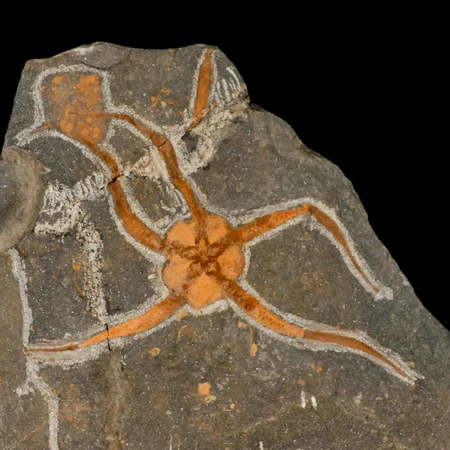
Albertosaurus, a prehistoric beast that lived during the late Cretaceous era, remains a constant source of intrigue to paleontologists and fossil collectors alike for years. Its size and unique features alone are enough to leave any trained fossil hunter speechless before an Albertosaurus specimen. Albertosaurus specimens are rather few compared to those of the fleshier, larger tyrant of dinosaur fossils, starfish fossils; however, a few of the most extraordinary fossils of Albertosaurus were discovered and will continue to amaze the scientific community. Here are five of the neatest Albertosaurus fossils that were dug up.
The 1991 Dinosaur Park Find
Possibly among the greatest finds of Albertosaurus fossils happened in 1991 right in Dinosaur Provincial Park in Alberta, Canada. A skeleton that is nearly 70% complete fossilizes in and out of this predatory dinosaur. Excellent remains have opened up vistas into the anatomy of Albertosaurus, including the configuration of its powerful jaws and agility. It is currently placed as one of the most impressive specimens in the world and is kept in a Canadian museum for further research.
Glen Rose Fossil
It unveiled an extraordinarily well-preserved Albertosaurus tooth and partial jaws. This find is not only helpful in understanding the dental morphology of Albertosaurus, but also points to a carnivore lifestyle. These kinds of fossils are very much in demand among collectors. Prices for Albertosaurus Fossils for Sale are, therefore, very high due to their scientific and aesthetic values.
The Fossil of 2005
The discovery was an important fossil of Albertosaurus found in 2005 in one of Alberta's rich fossil beds. It consisted of a partial skull with features distinctly marking it from any other theropods, and it helped portray the unique structure of Albertosaurus. Sharp teeth and hollow bones brought the suggestion that it had been built for speed and precision. This find is an important one for further separating Albertosaurus from its larger relatives like T-rex.
The Fossil of the Royal Tyrrell Museum
This fossil from Albertosaurus offers a peek into an almost 10-year-old individual not much older than young bighorn sheep. This fossil offers more stages in the developmental life of this species than fossils of adults or later-stage juveniles. These conditions are consistent with possessing a juvenile that died in a floodplain, making this specimen unique and rare in paleontological circles.
The "Starfish" Fossil Find
Not entirely unrelated to that of its namesake, some fossils have more loosely been tied to the ecology in which Albertosaurus would have lived. One of these examples is the rare starfish fossil in the same area where Albertosaurus remains were found: deep proof that ancient marine life thrived in that region. Although such fossils do not hold a direct link to Albertosaurus itself, they do influence the conditions that made its environment possible.
Albertosaurus fossils are a hot item even to collectors. So, if you want to buy Permian fossils for sale or even rare dinosaur remains, such as an Albertosaurus, reputable fossil dealers can be an excellent resource for sweet pieces of history that allow one to appreciate the marvel of prehistoric life. Whether looking for what becomes a starfish fossil to some and a dinosaur-full skeleton to others, the fossil world continues to yield such excellent treasure troves that strengthen our understanding of this planet during the ancient past.
Conclusion
So, here are the top five specimens of Albertosaurus fossils that are famed for their excellent states of preservation and the critical insights they proffer into the life of this extraordinary predator. If you are lucky enough to find Permian reptile fossils for sale
it is like holding a piece of ancient. History in your hands--a history that connects us to the creatures that once ruled the Earth millions of years ago.
For more information, Connect with Fossil Age Minerals.
0 notes
Photo

Dino 2: Spinosaurus
crocodile lookin ass get tf outta here
Reblogs > Likes !
#spinosaurus#Spinosaurus aegyptiacus#dinosaur#dino#dinosaurs#pterosaurs#xericeps#reptile#flying reptile#design#dino design#accurate spinosaurus#spinosaurs#theropod#paleoblr#dinoblr#paleontology#kem kem beds#fossil
46 notes
·
View notes
Text
Levi! The Babygirl Otaku Shut-in!
A small collection of blurbs/headcannons of what it's like to date Levi!
not edited

Leviathan, who streams for money. He’s introverted and a little shy, but when he is live streaming feels different. He is pretty popular too, and people think his expressiveness is pretty funny. He plays all different kinds, but everyone can tell he has a soft spot for indie games and dating simulators. After you guys start dating, he accidentally slips up and mentions you while playing one. It was a simple “Oh! Me and my s/o did something like this the other day lololol.” Chat went absolutely FERAL. Shut-in otaku Levi!?!? WITH A LOVER?!?!?! They were demanding for a reveal. He discussed if you were comfortable or not. If you said yes he would be absolutely ECSTATIC, he would be ok with a no tho, he gets it can be pretty stressful. If you would just like to be on call, no face that's cool! He gets so happy if you say you are fine with a full reveal, face and all!! Brags about you so much, his chat clowns him so hard. They stop calling him by his name and just call him your boyfriend. Ever since then you sometimes play games with him, your choice! The chat loves you two!!! They call you two couple goals when you start making fun of each other.
Levi really likes to visit the beach when he gets out of the house. Hope you can drive, he cannot. If you can’t, better start preparing those puppy dog eyes to convince Mammon to take you two to the beach. He really likes collecting seashells for Henry’s tank on the seashore with you. I think Levi would be really good at surfing!! He heard about it from the human world, and really wanted to give it a shot. He kills it!! He also likes having picnics there too. Cute foods or leftovers are all fine with him, he just thinks it's fun. He’s a sap.
He makes mixtapes for you. He knows people make playlists now, but he thinks having a physical one is a little more meaningful. He draws cute hearts and a picture of the two of you on the CD. Are there a lot of anime songs on there? Yes. Your point? Miku didn’t make these to go to WASTE!!!! Also includes songs that remind him of you, and songs you mentioned that made you think of him.
Levi is a little bit more weird on how he shows affection. He never really had a long term relationship (maybe not even short term ones…). He doesn’t always get it. Show him you love him though your ways and he’ll show you how he loves. Making couples cosplay to even outfits you said you wanted but they didn’t have the correct sizes or lengths. He likes when you wear these, as they leave marks of him on you. He also likes giving you items he owns to wear. Bracelets, pins, shirts, whatever you want you can have!! Levi gets a little possessive, especially since he doesn’t attend class in person a lot. He also might bring back fossils. He just thinks they're neat. Also, stuffed animals are a must. He gets them for you on instinct. They're cute like you, and are good for nests! (I like to think demons nest. That is what Levi's bathtub bed doubles as since hardly anyone comes into his room)
Continuing his strange affection streak: physical affection. He bites softly on your cheeks or arms, cuddles almost look like he’s killing you because he wraps around you like a snake, just funny little things that make you laugh sometimes. He also like to cuddle because he is naturally a little colder, because he is a reptile based demon. Will surprise you with his cold hands and laugh at your misery. Kiss him in public and he shuts up. I bet he is so ticklish from lack of touch hnrgh. Tickle him till he cries!!! His laugh becomes so ugly and he snorts and starts crying and it looks so CUTE!!!! He is just a touch starved cutie please give him all the lovings! Do expect revenge for this though, he is not a merciful demon.
I think he glows in the dark. Bio-luminescent sea creature my dudes(gender neutral)!!!! Night light boyfriend!!! He likes it when you kiss those marks, because for a long time he was insecure of them. Honestly? Loving any part of his demon form makes him feel better, because he still hates them. He has made an uneasy peace with a lot of it, but sometimes he still feels intensely disgusted by them. Ask him permission and Touch! His! Horns! Tell them how it reminds of coral (I think they might be based off of fire coral specifically?). Pet his tail!! He appreciates it, even if you sometimes have to chase it because he gets excited and it starts to wag. You feel like you're fighting a beast trying to catch it some days.
These ones are a little more serious. Please remember he has bad anxiety!! Depression also comes hard on him too. You can notice because his hygiene starts to slip first. Levi might be a shut in, but he doesn’t like to smell. He escapes for little showers, or at least takes rag baths. Please encourage him to shower, sometimes that means being in the bathroom with him, not always necessarily in the bath with him though. He just likes your presence, you never feel overwhelming to him. He might ask you to wash his hair at these times. Speaking might be too much in these times too. Just turn on Ruri-chan or the TSL movies. They’re his comfort shows. Let him take his time. He’ll tell you soon enough.
Back to light-hearted ones now!! Levi really likes terms of endearments. His favorite ones to call you is Henry, Player 2, and when he’s being really cringe “his Waifu/Husbando”. He also really likes calling you “his”, not in a toxic way. He just sometimes likes knowing that you are his like he is yours. Just calling you “his s/o” makes his heart flutter. Levi likes any name you give him! Obviously there are the ones that are the matching one to it, like “Lord of Shadows” and “Player 1”. Please babygirl him, he loses his mind. He CANNOT believe he’s your babygirl! HIM! He doesn’t like when you say it in public, he can only take so much!!!! Much more prefers being called it in private. He really likes any softer pet names, he’s a soft guy!
#leviathan x reader#leviathan x you#i am obsessed with him. I will not apologize.#bunny's.game.collection
162 notes
·
View notes